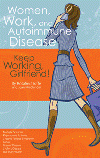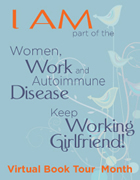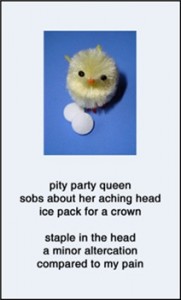 RSS FEED
RSS FEED
Archive for the ‘Books’ Category
The Language of Pain – a review
August 29th, 2010
 I recently finished The Language of Pain, by David Biro, M.D. A practicing physician in Brooklyn, NY, Dr. Biro also has a PhD in literature. This interesting combination of educational disciplines, together with Dr. Biro’s own experience as a patient with a blood disorder, leads to his thoughtful and philosophical writing on the isolating experience of pain. I presume that his earlier book, One Hundred Days: My Unexpected Journey from Doctor to Patient must focus more specifically on his personal (and unexpected) experience in bridging those worlds. The Language of Pain is a more general and outer-focused book, discussing how profoundly isolating the experience of being in pain is (be it physical or emotional pain) and how important it is to find means of expressing the experience.
I recently finished The Language of Pain, by David Biro, M.D. A practicing physician in Brooklyn, NY, Dr. Biro also has a PhD in literature. This interesting combination of educational disciplines, together with Dr. Biro’s own experience as a patient with a blood disorder, leads to his thoughtful and philosophical writing on the isolating experience of pain. I presume that his earlier book, One Hundred Days: My Unexpected Journey from Doctor to Patient must focus more specifically on his personal (and unexpected) experience in bridging those worlds. The Language of Pain is a more general and outer-focused book, discussing how profoundly isolating the experience of being in pain is (be it physical or emotional pain) and how important it is to find means of expressing the experience.
The Language of Pain is an interesting read, pointing out that an understandable expression of the pain one experiences is necessary both to get proper treatment for the pain (or the underlying condition that causes the pain), and to keep people in pain from being isolated from their families, friends and community. Drawing on many examples from art and literature, Dr. Biro explores how metaphor enables us to take the diffuse experience of pain and put it in terms that others can understand. The book is illustrated with some of Frida Kahlo’s gripping paintings, as well as patient-generated works of art gathered by Deborah Padfield in a pain clinic in the UK, and other art. We read many passages from literature describing pain, disease, and bodily peril, from works by Tolstoy, London, Crane and Joyce, among others.
This is not a long book, but it took me a long time to finish. I found that some of the descriptions of pain were, well, painful for me to read. It may be that for one living with chronic pain, this book hits too close to home. Nor is it an easy read. His points are excellent, but perhaps Dr. Biro couId have expressed them in a more accessible manner. This may sound funny coming from me; an inveterate user of big words. I could have used less literary and philosophical analysis and more practical examples of how finding language for their pain has helped pain patients.
The book is subtitled “Finding words, compassion and relief.” Without doubt the writing is compassionate, and ignites the reader’s compassion. There was inspiration for me personally in the examples of words used to express pain; certainly I remembered them in my own moments of pain, and tried to be more conscious of expressing myself. It is the “relief” that I would like to have heard more of in the book. Maybe because relief from pain is something I long for in my own life, and for other sufferers. It wouldn’t be fair for me to fault Dr. Biro for not providing a magic wand! He pulls it all together very well in his postscript, stating:
More than just communicating one person’s experience, the metaphors of great writers contribute to our collective experience of pain. They add to our ever-growing repository of language, and to our ever-growing understanding of what it means to be human. Indeed, we should think of our great artists no differently than our great scientists. Both have profoundly practical goals; each works to help us understand and talk about what is not fully understood or communicable. But where the scientist shines his searchlight on the objective world, the artist strives to illuminate the subjective one.
One of the things that fascinates me most is the meeting and communication of our left and right brains, our analytical and intuitive sides, the scientist and artist in each of us. I love thinking about what having both an MD and a PhD in literature would bring to a person’s thinking and understanding of the world. Dr. Biro thank you, you have done an elegant job of sharing your thinking with us. I’ll expose my own prejudices as a coach when I ask, next book, would you give us a little more of how to use those two sides of the brain for relief in our own lives?
– Megan Oltman
To keep the FTC happy I will disclose that the publisher asked me if I might like to review the book in my blog, and sent me a free copy so that I might do so. They did not pay me to puff the book, and I won’t receive anything else from doing this review unless some of you decide to link in to Amazon and buy it there, which would net me a few pennies per book. The publisher has no doubt given up on me, as they sent me the book before it’s publication in January of this year.
Tags: chronic pain, David Biro MD, Deborah Padfield, Frida Kahlo, Jack London, James Joyce, Leo Tolstoy, living with pain, pain, Stephen Crane, The Language of Pain
Posted in Books, Communicating, Managing, Medicine | Comments (0)
Hormones, Migraines and Menopause
February 14th, 2010
Migraines happen when those of us with excitable nervous systems – nervous systems prone to Migraine –  experience a change in our external or internal environment that triggers the Migraine process. This doesn’t explain what causes Migraine, or why some of us have nervous systems that react like this. It just describes the process. Hormonal fluctuations are one of the internal changes that can trigger a Migraine. Migraines are not “caused” by hormonal fluctuations, but hormones can be a big factor for many Migraine sufferers. One theory about why more Migraine sufferers are female, by a proportion of 3 to 1, is that the fluctuations of our hormonal cycles make us more susceptible. Interestingly, up to puberty the numbers of male and female Migraine sufferers are more even; many more girls join the ranks with the onset of puberty.
experience a change in our external or internal environment that triggers the Migraine process. This doesn’t explain what causes Migraine, or why some of us have nervous systems that react like this. It just describes the process. Hormonal fluctuations are one of the internal changes that can trigger a Migraine. Migraines are not “caused” by hormonal fluctuations, but hormones can be a big factor for many Migraine sufferers. One theory about why more Migraine sufferers are female, by a proportion of 3 to 1, is that the fluctuations of our hormonal cycles make us more susceptible. Interestingly, up to puberty the numbers of male and female Migraine sufferers are more even; many more girls join the ranks with the onset of puberty.
It’s hard to generalize with this disease; people are triggered by so many different things. Some women don’t notice any particular effect of hormones on their Migraines, others seem to be only triggered by hormones, and for some hormones are one of a host of possible triggers. That said, it is common for women to experience an increase in Migraines during peri-menopause, the period of years leading up to menopause when their hormonal levels are changing, and often beginning to drop off.
I had a sharp increase in Migraines, as well as onset of fibromyalgia, and increase in IBS as I moved into peri-menopause. I have found a bio-identical, bio-mimetic hormone replacement therapy which I believe has helped my overall health quite a bit. I started the program about 4 years ago. It has not had a noticeable effect on the number of my Migraines but has definitely decreased their severity. It has given me more energy and stamina overall, which has helped keep the fibromyalgia fairly mild, I believe. It also did away completely with many symptoms of menopause that were troubling me – hot flashes, night sweats, anxiety, insomnia, vaginal dryness. The program I use is known as The Wiley Protocol.

T.S. Wiley is a cancer researcher who hit on this method of replacing hormones in a pattern that mimics the hormonal patterns of a normal menstrual cycle. Her book, Sex, Lies and Menopause explains in great detail the effects of hormones on our bodies, on aging, and how she developed her protocol.
As I understand it, pharmaceutical HRT (hormone replacement therapy) chemically creates molecules which are similar to, but not identical to, the hormones our bodies produce. If the pharma companies are not inventing a new substance, they can’t patent it or make much money from it, so you don’t find these hormones advertised widely. Bio-identical HRT chemically synthesizes the exact same molecule our bodies produce, so that when we use it our bodies treat it as if we had produced it ourselves. Bio-identical HRT is made by compounding pharmacists. There are many producers of bio-identical HRT, some of them prescribe a constant level of the hormones to be used all the time. The drastic side-effects and health complications that come with pharmaceutical HRT are caused, Wiley says, by the fact that these are not molecules our bodies recognize, as well as by the fact that the hormones are dosed at a constant level which is not normal for our bodies. Bio-identical HRT can also cause problems when dosed at a constant level.
What is different about Wiley’s program is that the hormones are not just bio-identical, they are “bio-mimetic.” Wiley invented a method of dosing the hormones so they mimic the menstrual cycle of a healthy 20 year-old woman. The theory is to recreate a time when we are biologically at our healthiest, and giving our bodies the ebb and flow that is normal for them. Some women have bad Migraines when they are younger, and bad menstrual Migraines throughout their lives. I don’t know if the Wiley protocol would help them with their Migraines. But if the Migraines began or drastically increased in menopause or peri-menopause, it makes sense to me to replace the hormone levels of a time when you didn’t have the Migraines! The drawback, I suppose, is that as long as you are on the protocol you will menstruate. There are women in their 80’s on it, getting periods. But I have found that my periods on the protocol are very regular and fairly painless. The horrid PMS and menstrual Migraines I got in my peri-menopause years are gone, as are the terrible cramps I had, both when I was young and again in recent years.
Wiley does suggest that Migraines can be treated by spreading the hormones more evenly throughout the day, instead of just in the usual morning and evening doses. I have not tried this – it makes a certain degree of sense, in evening out any hormonal fluctuations during the day. Hormones do not seem to be the only thing that triggers my Migraines, though. If you read Wiley’s book or visit the site you might get the impression that the protocol is a panacea for all problems of aging. I don’t know if I buy into it that far, and as I said it has not been a complete solution for my Migraines. It has definitely made a big difference for me, though, and you may want to investigate it as a useful component of your toolkit.
Neither T.S. Wiley nor the Wiley Protocol has given me any payment for reviewing these products. If you click on the link to the book and buy it from Amazon, however, I will receive a small referral fee.
Tags: bio-identical hormone replacement, Hormones, Menopause, migraine, Migraine triggers, T.S. Wiley
Posted in Books, Managing, Medicine | Comments (1)
Express Migraine to Congress
October 24th, 2009
Betsy Blondin, editor and creator of the spectacular book of art and writing by Migraineurs, Migraine  Expressions, has created a new advocacy campaign. A friend suggested that people purchase a copy of Migraine Expressions for their U.S. Senator or Representative, to help raise awareness and understanding of our disease in Congress. Betsy loved the idea and launched the effort to “Express Migraine to Congress.” At least 7 books are on the way to Congress!
Expressions, has created a new advocacy campaign. A friend suggested that people purchase a copy of Migraine Expressions for their U.S. Senator or Representative, to help raise awareness and understanding of our disease in Congress. Betsy loved the idea and launched the effort to “Express Migraine to Congress.” At least 7 books are on the way to Congress!
To participate, purchase a book for $18.95 here: Express Migraine to Congress, and let Betsy know on the PayPal form or via e-mail which Congress person to send it to. Betsy will keep track of the Congress members receiving books so we won’t duplicate efforts on Betsy’s blog here. For each book purchased for Congress, Betsy will donate $1 to the Alliance for Headache Disorders Advocacy (AHDA) toward advocacy efforts.
If you can’t afford to buy a book, you can use the links on Betsy’s Senate and House of Representatives pages to send a message to your Congress members, asking them to help millions of Migraineurs by supporting Congressional hearings and increased funding for migraine research.
I’ll be going to the AHDA’s third Headache on the Hill day of advocacy in February, and these books sent to Congress beforehand will help raise awareness of what we are lobbying about. Momentum is building for Congressional action. Our lobbying efforts have resulted in legislative report language supporting increased attention by the NIH for migraine research. Cindy McCain coming forward as a Migraineur and pledging to advocate for Congressional hearings, has to increase our visibility.
Let’s support Betsy in this great idea to raise awareness!
– Megan Oltman
Tags: AHDA, Congress, Headache on the Hill, migraine advocacy
Posted in Advocacy, Books | Comments (0)
Treating-People-Like-Swine Flu
May 2nd, 2009
 I don’t know about you, but I was not at all shocked to learn that the CDC was investigating large-scale factory-farming pig feedlots in Mexico as the probable “ground zero” of the new H1N1 type A influenza mutation. Feedlots belonging to US agribusinesses, mind you.
I don’t know about you, but I was not at all shocked to learn that the CDC was investigating large-scale factory-farming pig feedlots in Mexico as the probable “ground zero” of the new H1N1 type A influenza mutation. Feedlots belonging to US agribusinesses, mind you.
According to David Kirby in the Huffington Post last week,
One of the first things they [the CDC] will want to look at are the hundreds of industrial-scale hog facilities that have sprung up around Mexico in recent years, and the thousands of people employed inside the crowded, pathogen-filled confinement buildings and processing plants.
“Swine Flu: Will Factory Farms Kill Millions?”
I’m not shocked, but I’m disgusted. Move the feedlots to Mexico where you can crowd people and animals in together in unsanitary conditions; let’s destroy the immune system of the world while we destroy the environment and the economy. Oh don’t get me started. Go read The Omnivore’s Dilemma. Buy local organic food.
As for me, I’m in bed for the last two days. My glands are painfully swollen, I have body aches and chills, I’m sneezing and coughing. I don’t have a fever or any respiratory distress, and my family members are taking good care of me, so don’t call 911. I don’t think I have swine flu but I feel awful so please forgive me if I’m behind on posting.
– Megan
Three pigs image courtesy of Eric Moeller.
Tags: Agribusiness, Organic Farming, Swine Flu
Posted in Books, Current Affairs, Rant | Comments (4)
Keep Working? But How? Author Rosalind Joffe Gives us Some Clues
November 18th, 2008
 Rosalind Joffe, co-author of Women Work and Autoimmune Disease: Keep Working Girlfriend stops in today on her virtual book tour. I asked Rosalind “how can we deal with the conflict between the need to slow down and care for ourselves, and the pace and intensity of the working world?” Here’s Rosalind’s response, in our guest post for today:
Rosalind Joffe, co-author of Women Work and Autoimmune Disease: Keep Working Girlfriend stops in today on her virtual book tour. I asked Rosalind “how can we deal with the conflict between the need to slow down and care for ourselves, and the pace and intensity of the working world?” Here’s Rosalind’s response, in our guest post for today:
Continuing to work – and managing to achieve some level of success – while living with chronic illness isn’t for everyone. Women Work and Autoimmune Disease: Keep Working, Girlfriend! explores the strategies and tactics that can help you. But the current work environment can pit us against our best desires to work and maintain a balanced life.
When my mother retired in 1992, she’d been working for 40 years. Testimonials at her retirement dinner reflected on her strong work ethic and her achievements. She’d reached an unusual level of success for a woman at that time in New York City public school administration. And she did it working between 40 to 50 hours/week, with a total of 3 months vacation yearly.
That’s just no longer possible. In the current labor market, the notion that there are no boundaries to the work day and working nights and weekends is the norm. Nor is this attitude limited to “white collar” or salaried jobs. Even hourly workers are expected to work more than their base time.
Cost cutting in a shrinking economy often means doing the same job that 1.5 or even 2 workers had done previously. In this 24/7 work world, too many organizations, big and small, assume that workers will be available whenever and wherever, regardless of the job or role in the organization.
So what does it mean for those of us whose personal resources are being taxed to the max due to a chronic illness?
First, take stock of your situation. Look carefully at who you are now and how you need to work so you can continue to work over the long haul. Throw the picture of “healthy you” in the trash – at least for now—and take a picture of you, right now, and tape it to your computer.
Now, think strategically. Give careful consideration to a career that offers relative stability. Although the current financial crisis shows us that nothing is for certain, some industries will always be more solid than others. You might want that sexy job but are you in a position to take the risk?
Additionally, when looking for a new job, focus on finding an organization that values its employees above all else. This can be the most critical element in your ability to keep working. My booklet, the Keep Working with Chronic Illness Workbook, complements the book. It has exercises and worksheets designed specifically with chronic illness issues in mind. Use this to seek work that meets your true needs and values.
Finally, no matter where you work or what you do, set limits. As long as you’re getting your job done to your satisfaction, you can decide where to set boundaries and draw the line.
At the end of the day, only you know if you can do the job. It often means modifying your own expectations. But when you take responsibility for managing your time and energy (even if you can’t make yourself healthy), you’ve put yourself in the driver’s seat. Remember, you could have a long work life ahead of you and now is the time to make it work for you.
Rosalind Joffe, co-author of Women, Work and Autoimmune Disease: Keep Working, Girlfriend! is president of cicoach.com, a resource for professionals who live with chronic illness. Check out her website CI Coach which is filled with resources about career challenges living with CI and her blog, Working with Chronic Illness.
Tags: autoimmune disease, career, chronic illness, working
Posted in Books, Managing | Comments (2)
November Blog Carnival: Art inspired by Migraine
November 11th, 2008

Go over to Pain in the Head for the November Headache and Migraine Disease Blog Carnival. Generally speaking, a blog carnival is a
collection of links to a variety of a blogs on a central topic. The
Headache & Migraine Disease Blog Carnival has been created to
provide both headache patients and people who blog about headaches with
unique opportunities to share ideas on topics of particular interest
and importance to us.
This month there are a number of posts containing art, and others about the relationship between Migraines and art. Many of us find creating art, whether with words, images or other materials, helps to soothe our pain and release our feelings. I want to give another plug here for Migraine Chick‘s new book of Migraine Haiku, which I mentioned a few weeks ago. Migraine Chick can make me laugh, and some of this haiku does that, with its biting cleverness. Some of the poems hurt too much to make me laugh, but they still provide the “aha!” of recognition and the satisfaction of meeting with another mind that really gets it. So check out the art in that book, and I hope also you go over to Pain in the Head and read some of the artful posts you find there.
– Megan Oltman
Tags: blog carnival, Migraine art, Migraine Haiku, Weblogs
Posted in Books, Managing, Weblogs | Comments (0)
Keep Working, Girlfriend! Book Tour
November 1st, 2008
 One of the most important issues for any of us facing chronic illness is the issue of staying employed, or
One of the most important issues for any of us facing chronic illness is the issue of staying employed, or
how to support ourselves while managing our illness. It is an issue we will be exploring at greater length in the coming months here at Free my Brain as we look at the merits and drawbacks of keeping a job, finding home-based employment, starting a business, or not working at all, when managing life with Migraine disease. Rosalind Joffe, Chronic Illness Coach, specializes in helping women with autoimmune diseases keep on working!
I’m participating in Rosalind’s Virtual Book Tour, along with other chronic illness bloggers, to bring attention to this important new book: Women, Work and Autoimmune Disease: Keep Working, Girlfriend! From Nov. 3 – Nov. 21, the other bloggers and I will be reviewing the book,
interviewing the author, hosting guest posts, and bringing attention to this important issue. Rosalind will be writing a guest post here  on Free my Brain on Tuesday, November 18. First stop on the tour will be at Rhymes with Migraine on November 3rd. In the meantime, please visit Keep Working Girlfriend for a list of the other bloggers/stops on the tour. You can also check out the book itself, which is described as a “voice of warmth, wisdom, understanding, and sisterhood,“ encouraging “women with chronic illness to stay as successfully employed as possible.” Click on the image of the book at the right to read more about it or purchase through Amazon.com.
on Free my Brain on Tuesday, November 18. First stop on the tour will be at Rhymes with Migraine on November 3rd. In the meantime, please visit Keep Working Girlfriend for a list of the other bloggers/stops on the tour. You can also check out the book itself, which is described as a “voice of warmth, wisdom, understanding, and sisterhood,“ encouraging “women with chronic illness to stay as successfully employed as possible.” Click on the image of the book at the right to read more about it or purchase through Amazon.com.
– Megan
Takes a licking but keeps on working!
Tags: autoimmune disease, chronic illness, Migraine disease, Rosalind Joffe, women, work
Posted in Books | Comments (0)
Migraine Haiku – Just for the Fun of it
October 23rd, 2008
We’ve got to laugh, otherwise we’ll cry. And you know crying is just going to make your head hurt worse, so why do it? Migraine Chick can always make me laugh, whether the deep belly laugh of recognition, or the delighted giggle of the absurd. She has published a book collecting her Migraine Haiku, together with her priceless illustrations, which is available at Migraine Chick Cafe Press for $13.95. I ordered mine.
Would you like your Migraines with or without giggles? I prefer mine with. I haven’t yet found the menu with just giggles, no Migraines.
– Megan Oltman
Fluffy chick and migraine haiku image copyright 2008 by Migraine Chick, of course.
Tags: haiku, laughter, migraine, Migraine Chick, poetry
Posted in Books, Silliness | Comments (0)
Coping with Migraine: Claims of a “Cure”
June 27th, 2008
I was recently presented with a dilemma here on Free my Brain. I want to encourage dialog and exchange of ideas, but I don’t intend to provide an open marketplace for sale of migraine “cures.” (Though I will gladly support and even promote helpful products and services.) Migraine is a complex, genetically based, neurological disease. The frequency and severity of migraines vary enormously from person to person; so do the number and complexity of triggers and other contributing factors. What we know now is that this is a neurological disorder, a differently ordered nervous system, if you will, which has existed throughout human history. Like many congenital conditions, there may have been a valid evolutionary reason for this mutation at one point. Maybe migraineurs were the human barometers, predicting disastrous weather changes for primitive societies. I had fun speculating on the evolutionary basis of migraine in the post Our Ancestress: A Fable.

I have heard from many people who have done just one thing and their migraines have gone away. To them I can only say mazel tov! (Congratulations!) Here is a bouquet of flowers to celebrate! For some it is eliminating just one trigger. For others it is a particular nutritional supplement, a practice of meditation, regular exercise, a medication, a surgery, pregnancy, menopause, a life or lifestyle change. I don’t know if there are statistics on how many migraineurs find relief from just one thing. I do know there are large numbers of us out here who need to find a combination of factors to manage and control our migraines. Here is a bouquet of flowers to console us! There is no “cure” for a genetically based neurological condition, any more than there is a “cure” for my red hair and green eyes. (Well, another 15 – 20 years may pretty well eliminate the red hair.)
A great place for some very basic facts and information about Migraine is the recent quiz at My Migraine Connection: Dispelling Migraine Myths. The two books on migraine featured in the left side-bar on this page are both great resources for learning about migraine and how to manage it. There is much we can do. For most of us, we can reduce our migraines significantly. You have probably heard me say before that I have reduced my own migraine frequency by about 50% through use of abortive medications, supplements, trigger avoidance, relaxation and meditation, and lifestyle changes.
Someone submitted a comment to one of my posts stating that 1) Migraine isn’t a disease; 2) there is a cure for Migraine “within us;” 3) he had over 20 years of migraines which are now gone; and 4) you can “retrain” yourself so you have no more migraines; he then went on to promote his methods. I am genuinely happy for the commenter that his migraines are gone. I am certainly curious about his methods, and glad that he wants to help others. I don’t mean to suggest he had any but the best motives. But I am wary of anyone’s claim to have a cure. After some deliberation, I decided not to publish the comment and link.
There are two ways to look at “retraining.” A nervous system which can be easily triggered into a Migraine attack can be viewed as an over-excitable or hyper-reactive nervous system. Regular practice of meditation and relaxation can help us reduce the excitability of our nervous systems. Note that this is not a “cure;” it is a supportive exercise or practice which can strengthen our system’s ability to resist triggers. You could call this “retraining.”
But there is another view of retraining which comes from an idea that Migraine disease is psychologically generated. It is not. It is a real, physical condition. It is no more psychological than epilepsy or scoliosis. I view with rage books like Louise Hay’s “You Can Heal Your Life” which suggest that right thinking can solve all our medical problems. She suggests that “Migraine headaches are created by people who want to be perfect and who
create a lot of pressure on themselves. A lot of suppressed anger is
involved…” 
And so, if we work like crazy in therapy, meditate, recite mantras and do whatever highly subjective steps Hay seems to think will enable us to let go of the anger and pressure, if we do all that and we still have Migraines, then what? We failed? It’s like telling someone the devil is causing their Migraines and they just have to really believe in God. “I do believe!” “If you really believed the devil would leave you and your Migraines would be gone!” “But I really do believe…” It’s just a very sneaky way of blaming the victim!
I wish we could do a scientific study of people who want to be perfect and who put pressure on themselves. In the first place I bet you that’s at least 75% of the population. And I bet you dollars to donuts that 12% of all the perfectionists would turn out to have Migraine disease. And I bet that 12% of all the non-perfectionists would have Migraine disease too. What’s the incidence of Migraine disease in the general population? 12%! I think you get my point.
I have been told that if I only distinguished the beliefs from my past that were making me have Migraines, they would disappear. I will admit I tried to do that. Like anyone else, I have a past and beliefs were formed in it! Some of those beliefs are limiting to me. In a life of nearly half a century, with plenty of self-help, support groups, personal development courses, and therapy, I think I’ve managed to identify most of those beliefs. So why am I not cured of Migraines? Is it my fault? Or, wait, could it be that I have a genetically based, incurable neurological condition? Hmmm… Which is the more logical conclusion? And which is more empowering?
For me, the answer is clear. I am 49, a woman, 5’2″, a redhead, a migraineur. These are facts. I get choices about what I do with those facts. I am choosing to vigorously pursue better and better Migraine management. I am not wasting my mental or emotional energy on “cures.” Or at least I won’t, once I’m done with this rant!
– Megan Oltman
Curing is good for meats, cheeses, wines, paints… Maybe our heads don’t need it?
Hammer image courtesy of Darren Hester
Tags: blaming the victim, evolution, genetics, Louise Hay, meditation, Migraine disease, Migraine management, nervous system
Posted in Books, Communicating, Managing, Medicine, Rant, Science | Comments (4)
“Breaking the Headache Cycle”
February 18th, 2008
Breaking the Headache Cycle by Ian Livingstone, M.D. and Donna Novak, R.N.
When my migraine pattern suddenly shifted from once month or less to three to four times per week, I  went to see Dr. Livingstone. When I first saw him in August of 2004, it was six months after I had two episodes of anaphylactic shock, caused by ibuprofen. I was a little gun-shy of trying new medications. I did agree to try Imitrex – I needed to be able to abort my attacks. But instead of preventive medications, Dr. Livingstone suggested that I get into a regular relaxation routine – using deep breathing, meditation and
went to see Dr. Livingstone. When I first saw him in August of 2004, it was six months after I had two episodes of anaphylactic shock, caused by ibuprofen. I was a little gun-shy of trying new medications. I did agree to try Imitrex – I needed to be able to abort my attacks. But instead of preventive medications, Dr. Livingstone suggested that I get into a regular relaxation routine – using deep breathing, meditation and
guided imagery to strengthen my nervous system’s relaxation response.
I first read the book at that time: Breaking the Headache Cycle: A Proven Program for Treating and Preventing Recurring Headaches. I took on practicing meditation daily, and after about six months I found my migraines reduced to 2 or 3 per month. The methods outlined in the book were very effective for me, in combination with the migraine abortive, to reduce my migraines to a manageable level.
The authors say migraineurs’ nervous systems are “very reactive to any change, even good change. This
sensitivity is the hallmark of the migraine condition. Unless it is understood and recognized, the migraine disorder cannot be adequately treated.”
If our nervous systems are over-responsive, it makes sense that relaxation and meditation will calm down the responsiveness of the nervous system. Dr. Livingstone cites studies showing that preventive medications reduce migraine about 40% on average (the book was published in 2003 – there may be more up to date statistics on this); and other studies showing that a regular relaxation practice reduces migraines 40% on average. Is it a safe bet to say if doing both, we might reduce migraine 80%? That’s a number I could be very happy with!
down the responsiveness of the nervous system. Dr. Livingstone cites studies showing that preventive medications reduce migraine about 40% on average (the book was published in 2003 – there may be more up to date statistics on this); and other studies showing that a regular relaxation practice reduces migraines 40% on average. Is it a safe bet to say if doing both, we might reduce migraine 80%? That’s a number I could be very happy with!
Many times I pause and do deep breathing when I first feel pain in my head, or even just when I feel my tension mount. This often down-shifts me from a budding migraine back to a state of no head pain. I have come to be able to notice when I am getting too excited or too engaged – it’s not just negative 
stress that can trigger me! Not surprisingly, when I got out of the habit of practicing regular relaxation, my migraines increased again. As tricky as
it is to remember to take a variety of medications, in the right amounts, at
the right times, I think it is even more challenging to establish and keep a
routine of putting the busy concerns of life aside and take time out to look
inward, breathe deep, become aware of the body, calm oneself, and relax.
I came to these methods already convinced – I was not a stranger to yoga, meditation and relaxation. I had practiced yoga in many periods in my life, starting in my teens, and meditation and guided imagery from my early twenties. Later, as a life and business coach, I have used meditation and guided imagery with my clients to help them get clear about issues that were stopping them, and to visualize what they wanted in their lives. So I wasn’t surprised that this practice would aid with migraine disease as well. The challenge is
keeping it in my life as all the demands of life crowd in. The reward is getting to know my own system
really well, and gaining at least a little bit of control over it.
By the way, I think preventive medication is a great thing, and many migraineurs find a lot of success with it. I may be headed down that path myself, as my migraine pattern has changed and my treatment will need to change too. But I’ll always keep relaxation as part of my routine. It makes me feel good!
– Megan Oltman
Nothing to gain from pain!
Tags: Breaking the Headache Cycle, Ian Livingstone MD, Migraine attack, Migraine preventive medication, reactive nervous system, relaxation practice
Posted in Books, Managing, Medicine, Tips & Techniques | Comments (2)
That disclaimer thing...
Remember: nothing we do here is medical advice or treatment or is a substitute for medical advice or treatment. Get competent medical advice to learn more about your migraines, possible treatments and risks.
What's New on Migraine Support Group Coaching |
Recent Comments
- on Calling all Redheaded Migraineurs
- on No, You’re not Crazy, You just Have Migraines
- on No, You’re not Crazy, You just Have Migraines
